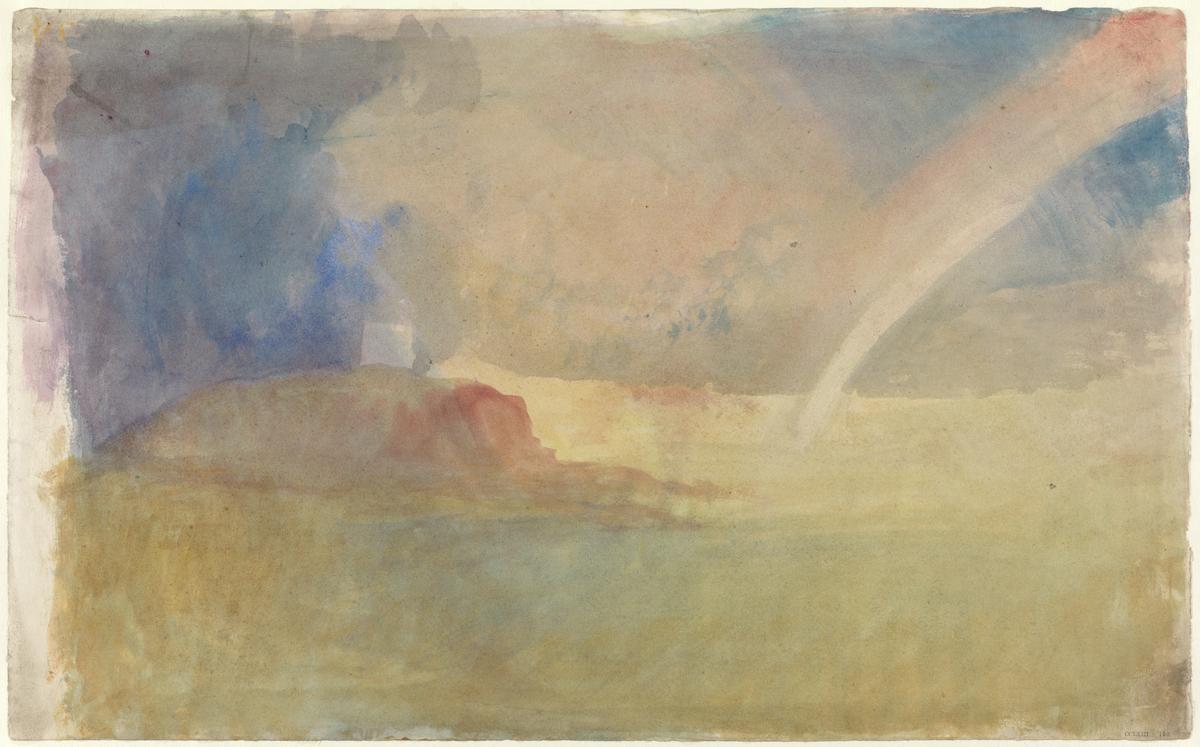Joseph Mallord William Turner Compositional, Colour and Underpainting Study for 'Plymouth' c.1825
Joseph Mallord William Turner,
Compositional, Colour and Underpainting Study for 'Plymouth'
c.1825
Joseph Mallord William Turner 1775–1851
Compositional, Colour and Underpainting Study for ‘Plymouth’ c.1825
D25272
Turner Bequest CCLXIII 150
Turner Bequest CCLXIII 150
Watercolour on white wove paper, 303 x 487 mm
Blind-stamped with Turner Bequest monogram towards bottom right
Stamped in black ‘CCLXIII–150’ bottom right
Blind-stamped with Turner Bequest monogram towards bottom right
Stamped in black ‘CCLXIII–150’ bottom right
Accepted by the nation as part of the Turner Bequest 1856
Exhibition history
1993
J.M.W. Turner 1775–1851: Impressions de Gran Bretanya i el Continent Europeu / Impresiones de Gran Bretaña y el Continente Europeo, Centre Cultural de la Fundació ”la Caixa”, Barcelona, September–November 1993, Sala de Exposiciones de la Fundación ”la Caixa”, Madrid, November 1993–January 1994 (38).
1994
J.M.W. Turner 1775–1851: Aquarelles et Dessins du Legs Turner: Collection de la Tate Gallery, Londres / Watercolours and Drawings from the Turner Bequest: Collection from the Tate Gallery, London, Palais des Beaux-Arts de Charleroi, September–December 1994 (38).
1997
Turner’s Watercolour Explorations 1810–1842, Tate Gallery, London, February–June 1997, Southampton City Art Gallery, June–September 1997 (27).
2002
Turner: Reflections of Sea and Light: Paintings and Watercolors by J.M.W. Turner from Tate, Baltimore Museum of Art, February–May 2002 (no catalogue).
2002
Turner y el mar: Acuarelas de la Tate, Fundación Juan March, Madrid, September 2002–January 2003 (23).
2003
O mar e a luz: Aguarelas de Turner na colecção da Tate, Museu Calouste Gulbenkian, Lisbon, February–May 2003 (24).
2006
Light into Colour: Turner in the South West, Tate St Ives, January–May 2006, Plymouth City Museum and Art Gallery, May–August 2006.
References
1909
A.J. Finberg, A Complete Inventory of the Drawings of the Turner Bequest, London 1909, vol.II, p.826, as ‘Tower on hill, with rainbow’.
1997
Eric Shanes, Turner’s Watercolour Explorations 1810–1842, exhibition catalogue, Tate Gallery, London 1997, pp.12–13; 51, no.27 reproduced in colour; 55, no.34; 94, Appendix I ‘Devonshire’; 100, Appendix I ‘Ports of England Series’.
This preliminary study for Turner’s Ports of England design of Plymouth sets out both the composition and the complex structures of colour and tone for the final work (Fundaçao Calouste Gulbenkian, Lisbon, Portugal).1 Like the finished watercolour Turner depicts the view near Mount Batten Point looking across Cattewater towards Plymouth Citadel.
The Turner scholar Eric Shanes has examined this study thoroughly for its colouristic arrangement and its relation to the final work. He writes:
The centre of this study was originally covered with a broad wash of yellow. When that had dried, the contours of the distant skyline were defined by overwashes of mauve and blue, and the rainbow was probably taken out with a damp, clean brush. A fundamental tonal reversal was effected in the final watercolour. Here the sky on the left is very dark, with the round fort on Mount Batten Point only slightly lighter in tone than its background, while the sky on the right is only darker than the rainbow in places. In the subsequent work Turner greatly strengthened the dazzling visual impact of the rainbow by wholly darkening the sky around it and lightening the sky on the left, with sunlight just catching the fort. There too the hillside beneath the fort extends further into the harbour, and the edge of its cliff is far less vertical in profile.2
Turner had previously pictured Mount Batten at Plymouth for the Southern Coast series in around 1816 (Victoria and Albert Museum, London) (see Tate impressions T04388, T05973, T05397).3 He knew the area well, making a number of preparatory sketches which can be found in the Ivy Bridge to Penzance sketchbook of 1811 (Tate D08866, D08869, D08874, D08878, D08879; Turner Bequest CXXV 2, 4, 9, 11a, 12) and the Plymouth, Hamoaze sketchbook of about 1812 to 1813 (Tate D09249; Turner Bequest CXXXI 30).
Despite Turner’s manifest knowledge of the area, the engraver Thomas Lupton (who subsequently produced the Plymouth mezzotint for the Ports series) claimed that Turner based the design for the original drawing (and thus presumably also for this preparatory study of it) on a sketch by Samuel Cousins R.A. ‘whose sketch-book [Lupton] lent Turner for the purpose’.4
Turner produced one further view of this area for the Ports of England series entitled Catwater, Plymouth produced in around 1826. There are two other colour sketches of the area (Tate D25344, D20217; Turner Bequest CCLXIII 222, CCXX J b). There is also a rainbow study that is possibly related to the present watercolour (Tate D25296; Turner Bequest CCLXIII 174).
Verso:
Stamped in black with Turner Bequest monogram and ‘CCLXIII–150’; inscribed in pencil ‘CCLXIII 150’ and ‘AB 150’ in a different hand all at top left.
Alice Rylance-Watson
March 2013
How to cite
Alice Rylance-Watson, ‘Compositional, Colour and Underpainting Study for ‘Plymouth’ c.1825 by Joseph Mallord William Turner’, catalogue entry, March 2013, in David Blayney Brown (ed.), J.M.W. Turner: Sketchbooks, Drawings and Watercolours, Tate Research Publication, September 2014, https://www

